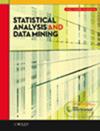基于帕累托类型分布下的期望值的新型两步外推-插入风险模型
IF 2.1
4区 数学
Q3 COMPUTER SCIENCE, ARTIFICIAL INTELLIGENCE
引用次数: 0
摘要
所开发的巨灾损失模型是保险业的一个挑战性问题。在帕累托类型分布的背景下,衡量右极端尾部的风险已成为学术研究的重点。正如中位数和平均数与中心行为的关系一样,分布的量值和期望值被认为是其尾部的有用描述符。本文介绍了一种新颖的两步外推-插入法,并通过渐近正态性对现有的远右尾数值模型进行修改,利用期望值和期望缺口(ES)的风险度量,从理论上证明了其偏差和方差较小的优点。此外,还提出了另一种基于拟合极值分布的 ES 求解方法,证明其具有优越的无偏统计特性。将这两种方法结合起来,就能获得保险业常用的基于真实量值的 ES 的数值区间上下限。丹麦再保险理赔数据的数值模拟和实证分析结果表明,这些方法在巨灾风险管理应用中具有很高的预测准确性。本文章由计算机程序翻译,如有差异,请以英文原文为准。
A novel two‐step extrapolation‐insertion risk model based on the Expectile under the Pareto‐type distribution
The catastrophe loss model developed is a challenging problem in the insurance industry. In the context of Pareto‐type distribution, measuring risk at the extreme right tail has become a major focus for academic research. The quantile and Expectile of distribution are found to be useful descriptors of its tail, in the same way as the median and mean are related to its central behavior. In this article, a novel two‐step extrapolation‐insertion method is introduced and proved its advantages of less bias and variance theoretically through asymptotic normality by modifying the existing far‐right tail numerical model using the risk measures of Expectile and Expected Shortfall (ES). In addition, another solution to obtain the ES is proposed based on the fitted extreme distribution, which is demonstrated to have superior unbiased statistical properties. Uniting these two methods provides the numerical interval upper and lower bounds for capturing the real quantile‐based ES commonly used in insurance. The numerical simulation and the empirical analysis results of Danish reinsurance claim data indicate that these methods offer high prediction accuracy in the applications of catastrophe risk management.
求助全文
通过发布文献求助,成功后即可免费获取论文全文。
去求助
来源期刊

Statistical Analysis and Data Mining
COMPUTER SCIENCE, ARTIFICIAL INTELLIGENCEC-COMPUTER SCIENCE, INTERDISCIPLINARY APPLICATIONS
CiteScore
3.20
自引率
7.70%
发文量
43
期刊介绍:
Statistical Analysis and Data Mining addresses the broad area of data analysis, including statistical approaches, machine learning, data mining, and applications. Topics include statistical and computational approaches for analyzing massive and complex datasets, novel statistical and/or machine learning methods and theory, and state-of-the-art applications with high impact. Of special interest are articles that describe innovative analytical techniques, and discuss their application to real problems, in such a way that they are accessible and beneficial to domain experts across science, engineering, and commerce.
The focus of the journal is on papers which satisfy one or more of the following criteria:
Solve data analysis problems associated with massive, complex datasets
Develop innovative statistical approaches, machine learning algorithms, or methods integrating ideas across disciplines, e.g., statistics, computer science, electrical engineering, operation research.
Formulate and solve high-impact real-world problems which challenge existing paradigms via new statistical and/or computational models
Provide survey to prominent research topics.
 求助内容:
求助内容: 应助结果提醒方式:
应助结果提醒方式:


